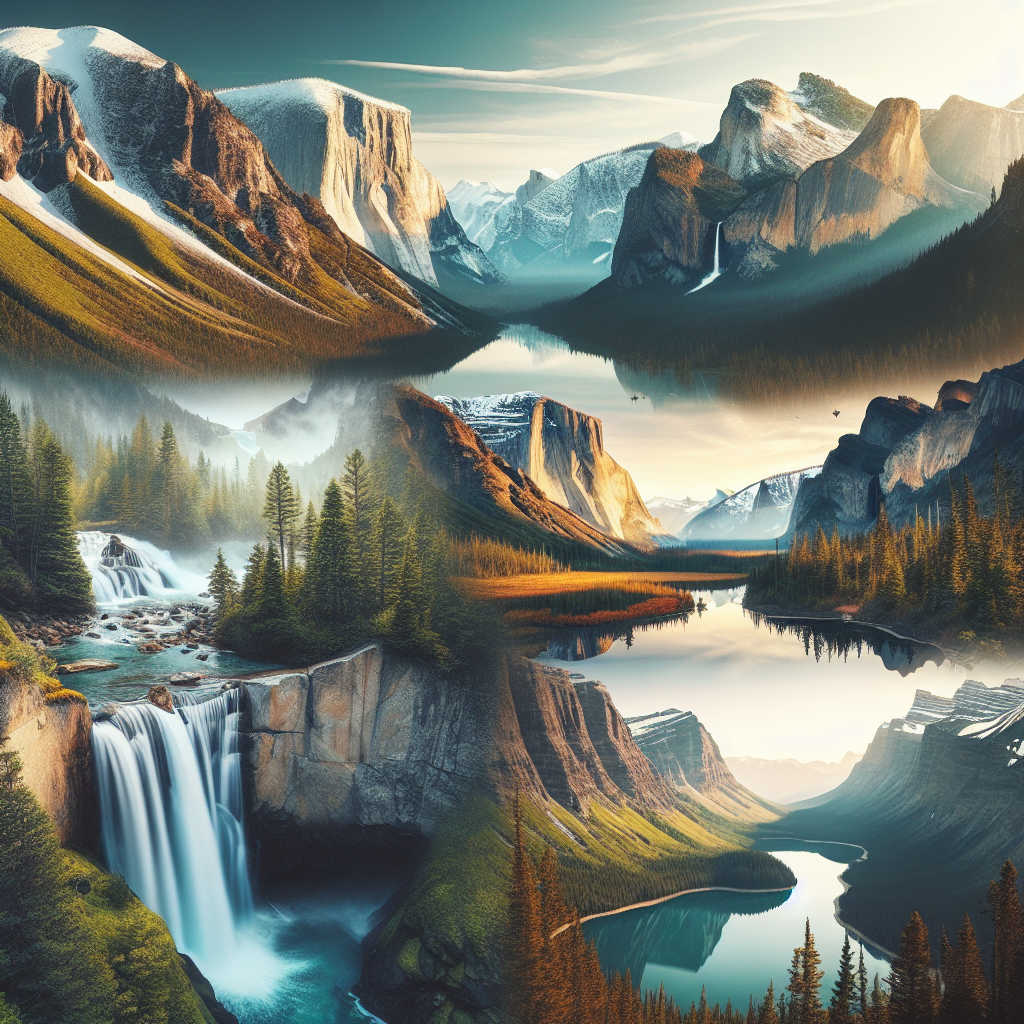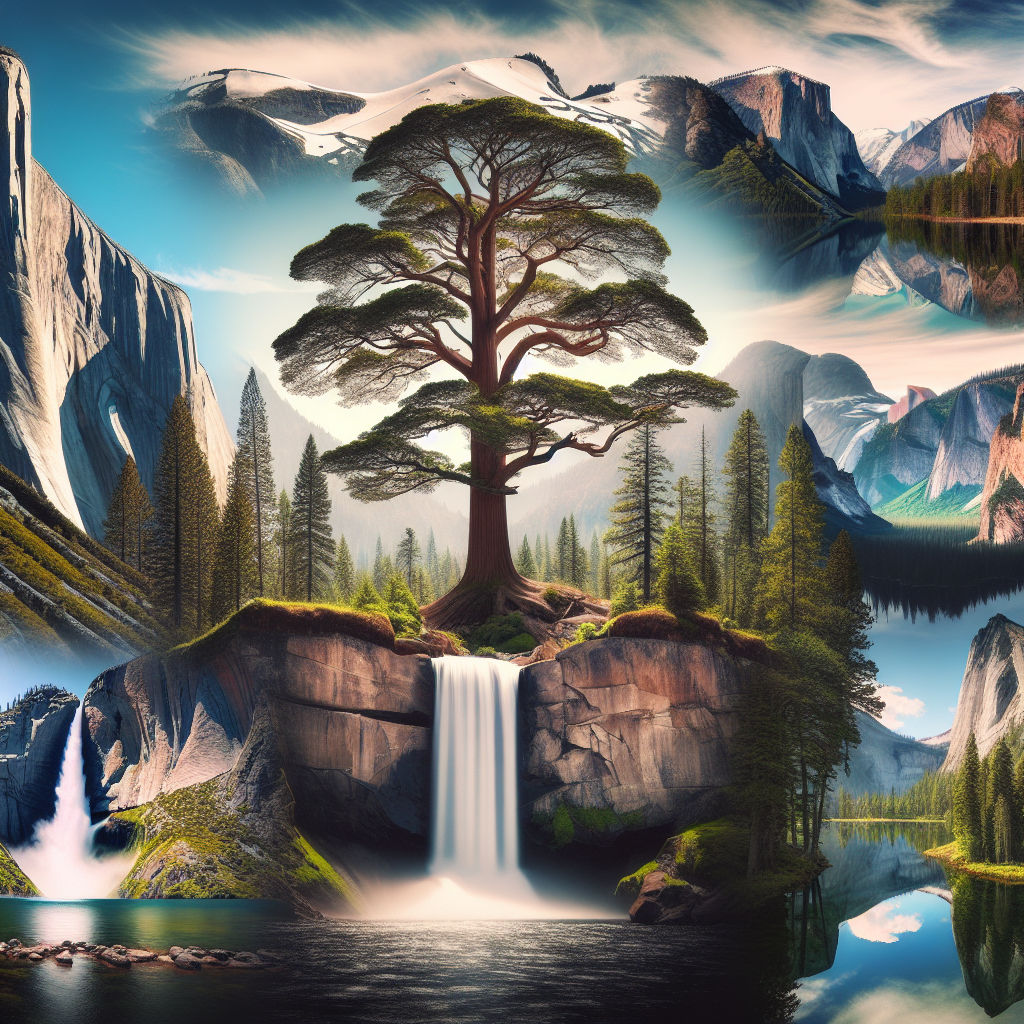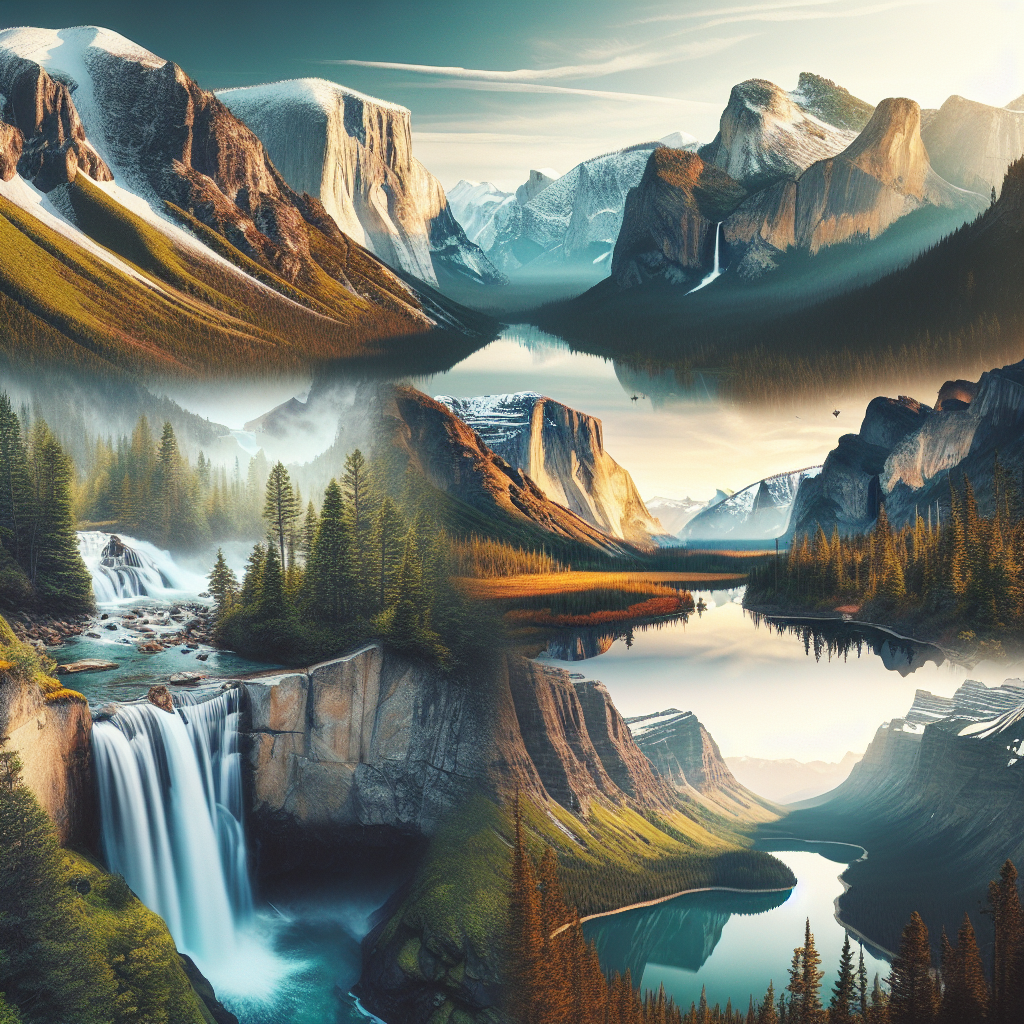Imagine embarking on an unforgettable adventure, surrounded by breathtaking landscapes and awe-inspiring natural wonders. “Exploring The National Parks Of The United States” invites you to dive headfirst into the enchanting realm of America’s national parks. Delve into the captivating beauty of Yosemite, experience the geological wonders of the Grand Canyon, and immerse yourself in the serene majesty of Yellowstone. In this article, you will discover the hidden gems and iconic landmarks that make each national park a unique and must-visit destination. Get ready to be mesmerized by the raw and untouched beauty of nature, as we guide you through the unforgettable journey of exploring the national parks of the United States.

Overview of National Parks in the United States
Understanding the concept of national parks
National parks are protected areas that are designated by the government to preserve and protect the natural and cultural heritage of a region. They serve as important spaces for conservation, scientific research, and recreational activities. National parks are managed by the National Park Service (NPS), an agency of the United States Department of the Interior.
Number and distribution of national parks in the US
The United States is home to a diverse array of national parks, each offering unique experiences and natural beauty. Currently, there are 63 national parks in the country, spread across different states and territories. From the towering cliffs of Yosemite to the geothermal wonders of Yellowstone, national parks can be found in every corner of the nation, allowing visitors to explore the country’s vast and varied landscapes.
Importance of national parks for conservation and recreational purposes
National parks play a crucial role in conserving and protecting the natural environment and wildlife. These protected areas provide habitats for numerous plant and animal species, ensuring their survival for future generations. National parks also offer a range of recreational activities, such as hiking, camping, wildlife watching, and photography, allowing visitors to connect with nature and enjoy outdoor adventures.
Popular National Parks
Grand Canyon National Park
Located in Arizona, Grand Canyon National Park is famous for its breathtaking views of the immense and colorful canyon carved by the Colorado River. It offers numerous hiking trails, scenic viewpoints, and opportunities for river rafting.
Yellowstone National Park
Yellowstone, spread across Wyoming, Montana, and Idaho, is the first national park in the United States. It is renowned for its geothermal features, including the iconic Old Faithful geyser, as well as its pristine lakes, waterfalls, and abundant wildlife.
Yosemite National Park
Yosemite National Park in California is known for its towering granite cliffs, including the famous El Capitan and Half Dome. The park offers scenic drives, hiking trails, waterfalls, and opportunities for rock climbing and camping.
Great Smoky Mountains National Park
Spanning Tennessee and North Carolina, Great Smoky Mountains National Park is the most visited national park in the United States. It boasts the beauty of the Appalachian Mountains, with diverse flora and fauna, hiking trails, and historical sites.
Acadia National Park
Located in Maine, Acadia National Park offers a stunning coastline, granite peaks, and picturesque lakes. Visitors can enjoy activities such as hiking, biking, camping, and exploring the park’s carriage roads.
Rocky Mountain National Park
Rocky Mountain National Park in Colorado offers breathtaking panoramic views of the Rocky Mountains, alpine meadows, and diverse wildlife. The park provides opportunities for hiking, wildlife watching, camping, and scenic drives.
Zion National Park
Zion National Park, located in Utah, boasts towering sandstone cliffs, deep canyons, and the picturesque Zion Canyon. It offers hiking trails, scenic drives, and opportunities for canyoneering and rock climbing.
Everglades National Park
Situated in Florida, the Everglades National Park is a unique wetland ecosystem that is home to various species of birds, reptiles, and mammals. Visitors can explore the park through airboat tours, hiking trails, and canoe or kayak excursions.
Glacier National Park
Glacier National Park, located in Montana, is known for its awe-inspiring glaciers, pristine lakes, and rugged mountain ranges. It offers hiking trails, scenic drives, camping, and opportunities to spot wildlife.
Denali National Park and Preserve
Located in Alaska, Denali National Park and Preserve is home to the highest peak in North America, Denali (formerly known as Mount McKinley). The park offers breathtaking landscapes, wildlife viewing, and mountaineering opportunities.
Unique Features of National Parks
Diverse landscapes and ecosystems
One of the remarkable aspects of national parks in the United States is the vast array of landscapes and ecosystems they encompass. From the desert landscapes of Death Valley to the lush rainforests of Olympic National Park, each national park offers a unique and diverse environment for visitors to explore and appreciate.
Iconic geological formations
National parks in the United States are known for their iconic geological formations. The towering cliffs of Yosemite Valley, the magnificent arches of Arches National Park, and the mystical hoodoos of Bryce Canyon National Park are just a few examples of the geological wonders that can be found within these protected areas.
Rare flora and fauna
National parks provide a sanctuary for rare and endangered plant and animal species. From the mighty sequoias of Sequoia and Kings Canyon National Parks to the elusive mountain goats of Glacier National Park, these parks offer visitors a chance to witness and appreciate the richness and diversity of the natural world.
Historical and cultural significance
Many national parks have significant historical and cultural value. Sites such as Mesa Verde National Park, known for its well-preserved cliff dwellings of the Ancestral Pueblo people, and Gettysburg National Military Park, commemorating the Civil War battle, allow visitors to step back in time and learn about the rich history and heritage of the United States.
Outdoor recreational activities
National parks provide a plethora of outdoor recreational activities for visitors of all ages and interests. Whether it’s hiking along scenic trails, camping under the stars, fishing in pristine lakes, or enjoying scenic drives, these parks offer endless opportunities for adventure and relaxation in the great outdoors.
Planning a National Park Visit
Researching the park’s attractions and facilities
Before visiting a national park, it’s essential to conduct thorough research about the park’s attractions, trails, facilities, and any specific regulations or restrictions. NPS websites and other reliable sources provide valuable information to help plan a successful and enjoyable trip.
Choosing the right time to visit
Timing is key when planning a national park visit. Considering factors such as weather, crowds, and peak seasons can greatly enhance the experience. Spring and fall often offer pleasant weather and fewer crowds, while summer provides longer daylight hours for extended exploration.
Making necessary reservations
Some national parks require reservations for camping, lodging, or specific activities, especially during peak seasons. It’s important to make these reservations well in advance to secure desired accommodations and make the most of the visit.
Transportation options
Considering transportation options is crucial, as national parks can be vast and require various means of transportation to explore fully. Many parks offer shuttle services, bike rentals, or guided tours to facilitate visitors’ movement and provide a convenient way to experience the park’s highlights.
Packing essentials for a national park trip
When packing for a national park trip, it’s essential to bring essentials such as comfortable hiking shoes, weather-appropriate clothing, sunscreen, insect repellent, a reusable water bottle, snacks, and a map or guidebook. Additionally, it’s crucial to pack any necessary camping or backpacking gear if planning an overnight stay.

Guided Tours and Activities
Ranger-led programs and guided hikes
National parks often offer ranger-led programs and guided hikes, allowing visitors to learn about the park’s history, geology, and ecosystem from knowledgeable park rangers or naturalists. These programs provide valuable insights and enhance the overall park experience.
Wildlife watching and photography
National parks provide incredible opportunities for wildlife watching and photography. Patience and respect for the animals’ natural behavior are crucial while observing wildlife. It’s important to follow park guidelines to ensure the safety of both visitors and the wildlife.
Camping and backpacking options
Many national parks offer camping and backpacking options for visitors who wish to spend more time immersed in nature. Camping provides an opportunity to connect with the natural surroundings and experience the peacefulness of the park after the day visitors leave.
Scenic drives and road trips
Scenic drives and road trips are a popular way to explore national parks, especially for those with limited mobility or time constraints. Many national parks have designated scenic drives that offer breathtaking views and access to key attractions.
Boating, fishing, and water activities
National parks with lakes, rivers, or coastlines often offer opportunities for boating, fishing, kayaking, or other water activities. These activities provide a unique perspective of the park’s landscapes and can be a refreshing way to enjoy the outdoors.
Tips for a Memorable National Park Experience
Respecting park rules and regulations
Respecting park rules and regulations is essential to ensure the safety of both visitors and the park’s natural and cultural resources. Following designated trails, refraining from littering, and keeping a safe distance from wildlife are crucial practices to uphold.
Packaging out waste and leaving no trace
To protect the fragile ecosystems of national parks, it is important to pack out any waste and leave no trace behind. This includes properly disposing of trash, using designated restrooms, and avoiding any actions that may harm the environment.
Preparing for unpredictable weather
National parks can experience unpredictable weather conditions, so it’s important to be prepared. Bringing layers of clothing, waterproof gear, and checking the weather forecast before heading out will ensure a comfortable and safe experience.
Staying safe in wildlife areas
National parks are home to an array of wildlife, and it’s important to observe these animals from a safe distance. Maintaining a respectful distance and refraining from feeding or approaching wildlife helps preserve their natural behavior and prevents potential conflicts.
Engaging in sustainable tourism practices
Visiting national parks with a focus on sustainability is crucial for their long-term preservation. Choosing eco-friendly accommodations, minimizing single-use plastics, and supporting local communities are all ways to engage in sustainable tourism practices.
Lesser-Known National Parks Worth Exploring
Channel Islands National Park
Located off the coast of Southern California, Channel Islands National Park offers a unique opportunity to explore undeveloped islands rich in natural beauty and marine biodiversity. Visitors can enjoy hiking, camping, kayaking, and snorkeling in this hidden gem.
Congaree National Park
Congaree National Park, situated in South Carolina, is home to one of the largest intact expanses of old-growth bottomland hardwood forest in the United States. Visitors can explore this enchanting forest through boardwalk trails, canoeing, or camping.
Isle Royale National Park
Located in the remote waters of Lake Superior, Isle Royale National Park is a wilderness island teeming with rugged landscapes, wildlife, and pristine lakes. Visitors can hike the extensive trail system, go boating, or enjoy world-class fishing.
Dry Tortugas National Park
Accessible only by boat or seaplane, Dry Tortugas National Park is a remote island paradise located 70 miles west of Key West, Florida. The park is renowned for its crystal-clear waters, coral reefs, and the historic Fort Jefferson.
Pinnacles National Park
Pinnacles National Park, located in Central California, is known for its unique rock formations, caves, and diverse habitats. Visitors can explore caves, hike through striking landscapes, and observe a variety of wildlife, including the endangered California condor.
Gates of the Arctic National Park and Preserve
One of the most remote and least-visited national parks, Gates of the Arctic National Park and Preserve in Alaska offers untouched wilderness, vast mountain ranges, and unspoiled rivers. Adventurous visitors can experience true solitude and pristine nature in this untouched wilderness.
Cuyahoga Valley National Park
Cuyahoga Valley National Park, nestled between Akron and Cleveland in Ohio, offers a beautiful blend of natural and cultural landscapes. Visitors can explore waterfalls, hike through lush forests, or even take a historic train ride through the park.
North Cascades National Park
Located in Washington state, North Cascades National Park is a paradise for outdoor enthusiasts. With its jagged peaks, alpine meadows, and pristine lakes, the park offers unmatched opportunities for hiking, backpacking, and mountaineering.
Guadalupe Mountains National Park
Guadalupe Mountains National Park, located in Texas, features the rugged and picturesque Guadalupe Mountains. Visitors can explore hiking trails that range from easy strolls to challenging summits or immerse themselves in the park’s rich cultural history.
Wrangell-St. Elias National Park and Preserve
Wrangell-St. Elias National Park and Preserve in Alaska is the largest national park in the United States, encompassing vast glaciers, majestic mountains, and pristine wilderness. This remote park offers adventurous activities such as mountaineering, backpacking, and wildlife watching.
National Parks for Thrill Seekers
Arches National Park
Arches National Park in Utah features more than 2,000 natural stone arches, unique rock formations, and a vibrant desert landscape. Thrill seekers can enjoy rock climbing, canyoneering, and hiking through stunning sandstone landscapes.
Joshua Tree National Park
Joshua Tree National Park, located in California, is famous for its unique Joshua trees and dramatic desert scenery. The park offers excellent opportunities for rock climbing, bouldering, stargazing, and exploring hidden desert oases.
Bryce Canyon National Park
Bryce Canyon National Park in Utah is renowned for its stunning hoodoos, multicolored rock formations, and expansive vistas. Visitors can hike down into the canyon, ride horses, or witness the magical night sky at the park’s observatory.
Haleakalā National Park
Situated on the island of Maui in Hawaii, Haleakalā National Park is home to the world’s largest dormant volcano. Visitors can experience the thrill of watching the sunrise from the summit, biking downhill along scenic roads, or hiking through otherworldly landscapes.
Olympic National Park
Olympic National Park in Washington state offers a diverse range of thrilling activities. From exploring glacier-capped mountains to hiking through pristine rainforests and rugged coastlines, visitors can indulge in backpacking, mountain climbing, kayaking, and more.
Mesa Verde National Park
Mesa Verde National Park in Colorado is renowned for its well-preserved cliff dwellings and archaeological sites of the ancestral Pueblo people. Visitors can hike to the ancient dwellings, learn about the rich history, and explore the park’s unique cultural heritage.
Badlands National Park
Located in South Dakota, Badlands National Park features stunning landscapes characterized by rugged rock formations, deep canyons, and unique geologic formations. Thrill seekers can enjoy hiking in the park’s otherworldly terrain or exploring its fossil exhibits.
Great Sand Dunes National Park and Preserve
Great Sand Dunes National Park and Preserve in Colorado offers the unique experience of exploring the tallest sand dunes in North America. Visitors can hike the dunes, sandboard down their slopes, or cool off in the nearby Medano Creek during the spring and summer months.
Volcanoes National Park
Volcanoes National Park, located on the Big Island of Hawaii, is home to two of the world’s most active volcanoes, Kīlauea and Mauna Loa. Visitors can witness the raw power of nature by exploring volcanic crater trails and experiencing the mesmerizing glow of lava at night.
Virgin Islands National Park
Virgin Islands National Park, spread across St. John, St. Thomas, and Water Island in the U.S. Virgin Islands, offers a tropical paradise with pristine beaches, coral reefs, and lush forests. Visitors can enjoy snorkeling, kayaking, and sailing in the crystal-clear Caribbean waters.
National Parks for Nature Lovers
Sequoia and Kings Canyon National Parks
Sequoia and Kings Canyon National Parks in California are home to some of the world’s largest and oldest trees, the giant sequoias. Nature lovers can explore the parks’ ancient groves, hike through breathtaking canyons, and discover stunning waterfalls.
Hawai’i Volcanoes National Park
Located on the Big Island of Hawaii, Hawai’i Volcanoes National Park showcases the power and beauty of active volcanoes. Nature lovers can hike along crater rims, explore lava tunnels, and witness the ever-changing landscapes shaped by volcanic activity.
Canyonlands National Park
Canyonlands National Park in Utah is a paradise for nature lovers, with its deep canyons, towering mesas, and dramatic arches. Visitors can marvel at the park’s stunning vistas, hike along scenic trails, or go on thrilling whitewater rafting trips on the Colorado and Green Rivers.
Everglades National Park
Everglades National Park in Florida is an expansive wetland ecosystem teeming with rare and endangered species. Nature lovers can explore the park’s vast network of waterways on guided boat tours, boardwalks, or by paddling a kayak through the mangrove forests.
Petrified Forest National Park
Petrified Forest National Park in Arizona offers a fascinating experience for nature lovers with its colorful petrified logs, unique rock formations, and ancient petroglyphs. Visitors can hike among the fossilized trees, explore scenic drives, or attend ranger-led programs to learn about the park’s geological and cultural history.
Redwood National and State Parks
Redwood National and State Parks in California are home to the iconic giant redwood trees, some of the tallest and oldest living organisms on Earth. Nature lovers can marvel at these majestic trees, hike through ancient forests, and explore pristine coastline.
Big Bend National Park
Big Bend National Park in Texas features breathtaking vistas of the Chisos Mountains, the Rio Grande River, and the vast Chihuahuan Desert. Nature lovers can hike along scenic trails, go bird-watching, or stargaze at one of the darkest night skies in the United States.
Shenandoah National Park
Situated in Virginia’s Blue Ridge Mountains, Shenandoah National Park offers stunning vistas, cascading waterfalls, and diverse flora and fauna. Nature lovers can hike the famous Appalachian Trail, enjoy scenic drives on Skyline Drive, or spot wildlife in the park’s verdant forests.
Katmai National Park and Preserve
Katmai National Park and Preserve in Alaska is known for its abundant population of brown bears, which gather at Brooks Falls to feast on migrating salmon. Nature lovers can witness this incredible spectacle, as well as explore the park’s vast wilderness, rugged coastlines, and volcanic landscapes.
Crater Lake National Park
Crater Lake National Park in Oregon is centered around the deep blue Crater Lake, the deepest lake in the United States. Nature lovers can hike along the caldera rim, explore the park’s old-growth forests, and witness the pristine beauty of this natural wonder.
Conclusion
Appreciating the natural and cultural treasures of national parks is an enriching and fulfilling experience. The United States is blessed with a diverse range of national parks, each offering unique landscapes, wildlife, and recreational activities. By planning a national park adventure, visitors can immerse themselves in the beauty of nature, learn about the country’s rich history and heritage, and contribute to the conservation and preservation of these priceless treasures. So why wait? Start planning your national park adventure today and embark on an unforgettable journey into the heart of America’s natural wonders.

